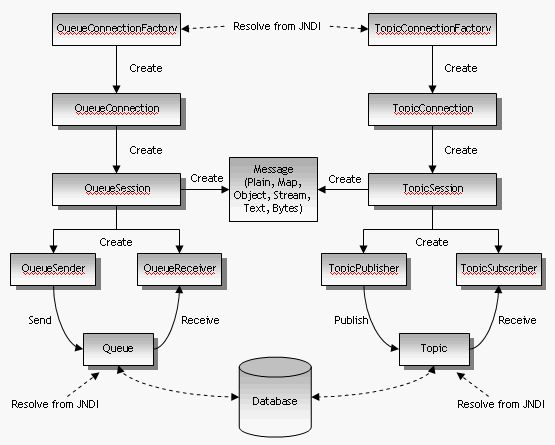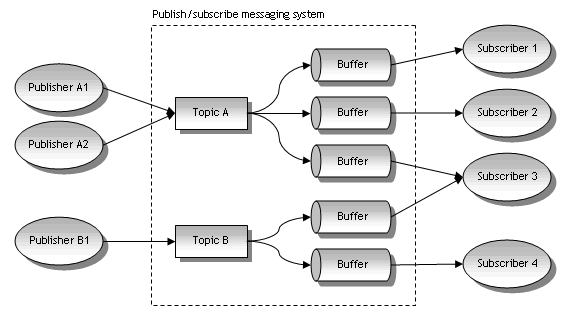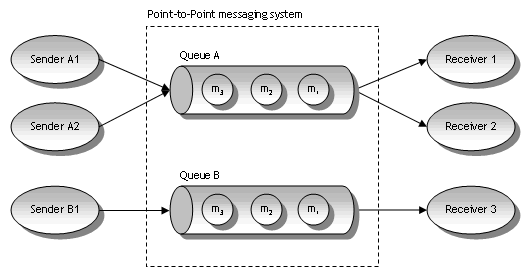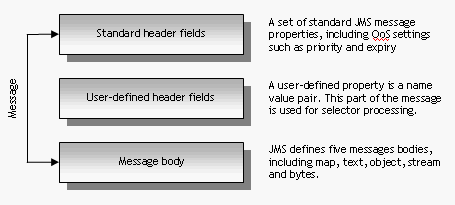
The main concepts in JMS are shown in the figure below. The left side illustrates the Point-to-Point (P2P) model and the right side illustrates the Publish and Subscribe (Pub/Sub) model. In P2P messaging senders and receivers are de-coupled by a queue. In Pub/Sub messaging, the publishers and subscribers are de-coupled by a topic.
The names in the boxes in the figure denote Java interfaces, which a client application must use the interact with JMS. Although the Pub/Sub and P2P messaging models are different from a conceptual point of view, there is a high degree of commonality and JMS is centered around a generic messaging model where Pub/Sub and P2P are merely specializations.

A JMS application consists of several components:
| Component | Function |
| Clients | A user that can send and receive messages. JMS clients send and receive messages between Java applications. Non-JMS clients use a client API native to the messaging system they run on. Some messaging applications, written before JMS was developed, support both JMS and non-JMS clients. |
| JMS provider | The host application on which the JMS application runs. The JMS provider communicates with the JMS application and supplies the controls, functions, and underlying mechanisms required by a robust messaging application. |
| Messages | Bundles of information that are passed between applications. Each application defines the types of information a message can contain. |
| Administered objects | JMS objects, which are created and configured by an administrator to be used by clients. Administered objects are not tied to any proprietary aspects of a provider, so JMS clients can remain portable. |
In general, JMS applications have to perform the following five steps in order to start sending or receiving messages:
The database in the figure above is shown to illustrate that JMS will store persistent messages for recovery purposes in some store. Some JMS vendors might use a file-based store instead of a database. JMS does typically not use a database when handling non-persistent messages.
JMS defines two message models: Publish and Subscribe (Pub/Sub) and
Point-to-Point (PTP). The JMS specification requires that an implementation
must support at least one model. Since both models share the same common
framework they can both deliver messages synchronously or asynchronously to
consumer applications.
The Pub/Sub model publishes (distributes) messages on either a one-to-many
or a many-to-many basis. Examples include:
Messages are published to topics by one or more topic publishers. Interested
users subscribe to one or more topics in order to receive those messages. A
subscription to a topic can be made either durable or non-durable.
The Point-to-Point (PTP) model distributes messages on a one-to-one basis.
Examples include:
A message is sent to a specified queue. Messages in a queue are processed on a
first-in, first-out (FIFO) basis. Unlike the Pub/Sub model, where one message
is delivered to several subscribers, each message in the PTP model can be
delivered to only one receiver.
A receiver takes the first message in a queue, then the second, and so on. A
receiver can also browse the messages in a queue - for example, to count them
- but cannot receive messages out of sequence, or change the messages in any
way.
Messages, in the context of message-oriented middleware and JMS, are not
traditional e-mail messages. Rather, they are formatted data - requests,
events, or status - that are passed between enterprise applications.
JMS provides a single, unified message API that is used to pass messages
between otherwise incompatible applications. JMS applications can also pass
serializable Java objects to other Java-based applications.
Because JMS provides several message body forms, the message formats used by
non-Java applications can be duplicated and passed along. JMS applications do
not have to understand the content of the messages they pass.
All messages support the same set of header fields. The following table
describes some of these fields. Refer to the JMS specification for a complete
listing.
Nonpersistent (or reliable) delivery means that although a reasonable attempt is made to deliver the message, it can still be lost in the event of a system failure. These messages are delivered at most once. Non-persistent delivery requires lower overhead and is used in situations where guaranteed delivery is not required.
Properties are values that can add to the information contained in header fields, or convey vendor- or application-specific information. JMS defines specific properties and reserves a block of names for them. It also provides a naming convention for provider-specific properties.
Properties can be set when a message is sent, or by consumers upon receiving the message. Along with header fields, properties can be used by the application to filter and route messages based on specified criteria.
Property values can be of the type boolean, byte, short, int, long, float, double, and String. JMS provides a method to retrieve an enumeration of all property names and methods to retrieve the values of the named properties.
JMS defines six message types:
An administered object is one that is created by the administrator of the JMS
provider application. Administered objects are placed in a JNDI namespace, and
can be administered from a common management console. JMS has two types of
administered objects, namely destinations and connection factories.
The
Destination
object contains address names and configuration information supplied by the
JMS provider. The client uses this object to specify a destination for
messages it sends, and a location from which the messages it receives
originate.
There are two types of Destination interfaces - one for each message model.
For the Pub/Sub model, the destination is called a
Topic
For the PTP model, it is called a
Queue
The
ConnectionFactory
enables a client to create a connection with the JMS provider. It contains
connection configuration information that has been defined by an administrator,
and it is retrieved using JNDI.
As the name indicates, the connection factory can create connections to a
JMS provideer. In the Pub/Sub model, the connection factory is called
TopicConnectionFactory
; in PTP, it's called
QueueConnectionFactory.
JMS defines interfaces that create and manage connections. The set of
interfaces you use depends on whether your application uses Pub/Sub or PTP.
The JMS specification further defines XA variants of most of these interfaces,
which are used for transactional messaging:
![]() Pub/Sub Message Model
Pub/Sub Message Model

Subscription
Description
Durable
A subscriber receives messages from a specified topic when the subscriber is online. Durable subscriptions require more overhead because messages must be stored until they are delivered.
Non-durable
Messages published to a specified topic exist only for the lifetime of the subscriber. As long as the subscriber is active, it receives messages from subscribed topics. If no subscribers to a topic are online to receive messages, the messages are destroyed.
![]() PTP Message Model
PTP Message Model

Message Structure

![]() Message Header
Message Header
Field
Description
Time to expire
The length of time a message can exist before it expires and is destroyed
by the provider. Expiration can be set to zero, which means the message will
not expire.
Persistent and
non-persistent
deliveryPersistent (or guaranteed) delivery means that delivery of a message is assured; it will persist until it is received by all subscribers who requested it. The message is delivered once and only once.
Priority
Messages with a higher priority are delivered before messages with a lower priority; however, this is not guaranteed. There are 10 priority levels - from 0 the lowest to 9 the highest.
Redelivered flag
Notifies the client that this message was probably received by the client before, but for whatever reason, the client did not acknowledge its receipt. This flag is set by the JMS provider application, usually as the result of a recovery operation.
Reply to
Contains a Destination, provided by the client, indicating where a reply to this message should be sent. When this field is filled, a response is generally expected.
![]() Message Properties
Message Properties![]() Message Body
Message Body
Form
Content
Message
A plain message with no body. This message consists only of the header
and properties.
ByteMessage
A stream of uninterpreted bytes. This form can be used to encode information to match formats used by legacy messaging applications.
MapMessage
A set of name/value pairs. The name is a String and the value is a Java primitive type.
ObjectMessage
A single serializable Java object or a collection of objects.
StreamMessage
A stream of Java primitive values that are entered and read sequentially.
TextMessage
Text formatted as a java.lang.String. This form is well suited to pass XML data.
Administered Objects
![]() Destination
Destination![]() Connection Factory
Connection FactoryJMS Interfaces
Parent interface
Pub/Sub model interface
PTP model interface
ConnectionFactory
TopicConnectionFactory
QueueConnectionFactory
Connection
TopicConnection
QueueConnection
Destination
Topic
Queue
Session
TopicSession
QueueSession
MessageProducer
TopicPublisher
QueueSender
MessageConsumer
TopicSubscriber
QueueReceiver,
QueueBrowser
Parent interface
Pub/Sub model interface
PTP model interface
XAConnectionFactory
XATopicConnectionFactory
XAQueueConnectionFactory
XAConnection
XATopicConnection
XAQueueConnection
XASession
XATopicSession
XAQueueSession
Copyright © 1998-2003, Novell, Inc. All rights reserved.